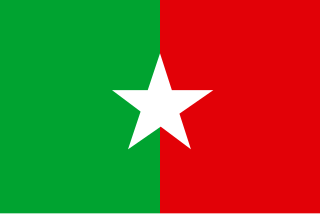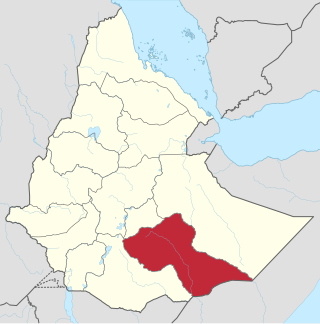Related Research Articles

The Somali Region, also known as Soomaali Galbeed and officially the Somali Regional State, is a regional state in eastern Ethiopia. Its territory is the largest after Oromia Region. The regional state borders the Ethiopian regions of Afar and Oromia and the chartered city Dire Dawa to the west, as well as Djibouti to the north, Somalia to the northeast, east and south; and Kenya to the southwest.

Ogaden is one of the historical names used for the modern Somali Region which forms the eastern portion of Ethiopia and borders Somalia. It includes another region in the north known as the Haud.

The Western Somali Liberation Front was an Ogaden separatist group fighting in eastern Ethiopia to liberate the Ogaden region from Ethiopian control. It played a major role in the Ogaden War of 1977–78, assisting the invading Somali Army.

Jijiga is the capital city of Somali Region, Ethiopia. It became the capital of the Somali Region in 1995 after it was moved from Gode. Located in the Fafan Zone with 70 km (37 mi) west of the border with Somalia, the city has an elevation of 1,634 metres above sea level. Jigjiga is traditionally the seat of the Bartire Garad Wiil-Waal of the Jidwaaq Absame. The International airport is named after him.

Bale, also known as Bali, is the name of two former polities located in the southeastern part of modern Ethiopia.

The Hawiye is the largest Somali clan family. Members of this clan traditionally inhabit central and southern Somalia, Somaliland, Djibouti, Ethiopia and Kenya. They are also the majority in the capital city, Mogadishu.
The Habr Garhajis also contemporarily known as the Garhajis is a major clan of the wider Isaaq clan family. They are the traditional holders of the Isaaq Sultanate and Habr Yunis Sultanate since the 18th century. As descendants of Ismail bin Sheikh Isaaq, its members form a part of the Habar Magaadle confederation, and they constitute the largest sub-clan of the Isaaq. The Garhajis are divided into two major sub-clans: the Habr Yunis and Eidagale. They are traditionally nomadic pastoralists, merchants and skilled poets.

The Marehan is a Somali clan, which is part of one of the largest Somali clan families, the Darod.

The Rahanweyn, also known as the Digil and Mirifle are a major Somali clan. It is one of the major Somali clans in the Horn of Africa, with a large territory in the densely populated fertile valleys of the Jubba and Shebelle rivers and the areas inbetween which are mainly inhabited by settlers from the Digil and Mirifle lineages.

Shabelle is one of nine Zones of the Somali Region of Ethiopia. It was previously known as Gode, so named after its largest city, Gode. Shabelle is bordered on the west by Afder, on the north by Fiq, on the northeast by Korahe. On the south it borders the Provisional Administrative Line of Somalia along the borders of the Hirshabelle and Galmudug federal states.
Danan is one of the districts in the Somali Region of Ethiopia, named after its major town, Danan. Part of the Gode Zone, Danan is bordered on the south by Gode, on the west by Imiberi, on the north by the Fiq Zone, and on the east by the Korahe Zone.
Gode (Godey) is a woreda in the Somali Region of Ethiopia, named after its major town, Gode. Part of the Gode Zone, Gode is bordered on the south by the Shebelle River which separates it from Adadle, on the northwest by Imiberi, on the north by Danan, on the northeast by the Korahe Zone, and on the southeast by Kelafo.
Over the course of the Somali Civil War, there have been many revolutionary movements and militia groups run by competing rebel leaders which have held de facto control over vast areas within Somalia.

The Bimaal or Bimal, is a sub-clan of the major Dir clan family. This clan is widely known for leading a resistance against the colonials in southern Somalia for decades which can be compared to the war of the Sayyid in Somaliland. The Biimaal mainly lives in southern Somalia, the Somali region of Ethiopia, which their Gaadsen sub-clan mainly inhabits and in the NEP region of Kenya.
Gode is a city in the Somali Region of Ethiopia. Located in the Shabelle Zone, the city was the capital of the Somali Region until 1995 when Jijiga became the capital
Imi is a town in the Somali Region of Ethiopia. It is currently divided to two separate towns. East Imi located in Imiberi woreda of the Gode Zone and West Imi located in Mirab Imi woreda of the Afder Zone. The Shebelle River runs between these towns. It's located at latitude and longitude 6°28′N42°10′E with an elevation of 442 meters above sea level.
Mustahīl is a town in eastern Ethiopia, close to the border with Somalia. Located in the Gode Zone in the Somali Region and straddling the Shabelle River, it has a latitude and longitude of 5°15′N44°44′E with an altitude of 193 meters above sea level. It is the main town of the Mustahīl woreda.
The Sultanate of Bale was a Somali Muslim Sultanate founded in the Bale Mountains of the southern Ethiopian Highlands and Horn of Africa. It corresponds roughly to the modern Bale Zone of the Oromia Region in Ethiopia.
Sheikh Mohamed Hikam Sheikh Abdirahman was an ethnic Somali Islamic scholar originating from the Somali region of Ethiopia. He was born around the 1920s in the district of Babile, which is around 76km east of the historical city of Harar. He was an Islamic scholar, community elder, reformer, poet, freedom fighter and formidable peace negotiator in the clan-dominated, lawless Somali region in the 1960s. He studied Islamic religion with a famous sheikh called Sheikh Abdiweli Gurgure at Belbeleyti area of Oromia region in the 1940s-50s.
The Abaskuul, Abasguul, Abasgul or Abaskul is a Somali sub-clan of the Jidwaaq, Absame, Kumade, Kablalah, Darod line. The Abaskuul mainly reside between Jigjiga and Degahbur in the Somali Region in Ethiopia, but also have settlements in Jubaland (Somalia) and Kenya. They share borders with the Ogaden, Bartire, and Habar Awal clans. The Abaskuul were famously described in Richard Burton's First Footsteps in East Africa, as well as 17 Trips to Somaliland and a Visit to Abyssinia by Captain Harald G. C. Swayne.
References
- ↑ Hammarström, Harald; Forkel, Robert; Haspelmath, Martin, eds. (2017). "Rer Bare". Glottolog 3.0 . Jena, Germany: Max Planck Institute for the Science of Human History.
- ↑ Hagmann, Tobias (2005): Challenges of decentralisation in Ethiopia's Somali Region, Briefing for Review of African Political Economy Vol. 32, No. 103, p. 5
- ↑ Braukämper, Ulrich (2003): Islamic History and Culture in Southern Ethiopia. Collected Essays, Göttinger Studien zur Ethnologie 9, ISBN 978-3-8258-5671-7 (p. 15, 137)
- ↑ H. G. C. Swayne, "A Trip to Harar and Imé", Geographical Journal, 2 (September 1893), p. 251